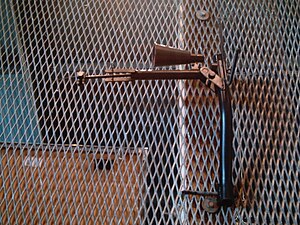SM-70
| Splittermine Modell 1970 | |
|---|---|

Fence-mounted SM-70 at the Observation Post Alpha museum
|
|
| Type | Directional anti-personnel mine |
| Place of origin |
|
| Service history | |
| In service | 1970–1984 |
| Used by | East Germany |
| Wars | Cold War |
| Production history | |
| No. built | 60,000 |
| Specifications | |
| Weight | 191 g |
| Length | 350 mm |
| Diameter | 150 mm |
|
|
|
| Effective firing range | 25 m |
| Maximum firing range | 120 m |
| Filling | 110 g TNT explosive ~80 steel cube projectiles |
|
Detonation
mechanism |
Tripwire initiated N-172 (pull or tension release) |
The SM-70 (Splittermine Modell 1970) was an East German directional antipersonnel mine developed specifically to combat Republikflucht (defection) across the Inner German Border (Grenze) into West Germany.
First fielded in 1970, the mines were cone-shaped, tripwire activated, and mounted to concrete posts along the line of climb-resistant prefabricated steel mesh fence. In some cases, they were mounted directly to the fence itself. They were aimed parallel with the fence line, and intended to kill or incapacitate anyone attempting to climb or cut through the fence.
Beginning in late 1970, approximately 60,000 SM-70s were installed on 440 kilometers (273 mi) of particularly escape-prone rural sections of the East German border. Installation of the mines cost 100,000 East German marks per kilometer, for a total cost of over 44 million marks. The mines were not used on the Berlin Wall. Initial plans called for the SM-70 to completely replace the buried PMN anti-personnel mines along the border, but initial problems with the electrical firing devices after exposure to the elements actually resulted in more PMN mines being emplaced as a stopgap measure. When fired, the SM-70 produced a cone of fire lethal within 25 meters (82 ft). One East German described finding a deer shredded by an SM-70, noting that a 5 m area "appeared as if it had been worked over by a rake."
Although referred to within the Border Guards by the National People's Army designation G-501, for propaganda purposes the mines were referred to as "Automatic Firing Devices" (German: "") in public documents. The cryptic description led to the public perception that the mine was a type of automated sentry gun (rather than a simple static trip-mine), a misconception shared even with Western intelligence agencies. In fact, no such technology existed during the lifespan of East Germany, and the mine was actually more similar in capability to an oversized spring gun, but the rumors provided an additional psychological deterrent to would-be border crossers. From 1973 onward, the mines were enclosed in a plastic box housing for protection from the elements, further concealing their design from onlookers.
...
Wikipedia
